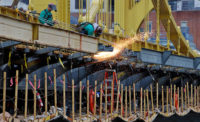Viewpoint: US Infrastructure Needs Disruption
By Norman F. Anderson
Norman F. Anderson is CEO of consulting firm CG/LA Infrastructure and directs Blueprint 2025, a CEO-led initiative to draft a comprehensive infrastructure plan for the next administration. CG/LA will host the top 50 strategic infrastructure projects in North America at the 8th North American Infrastructure Leadership Forum on October 24-27 in Denver. He can be reached at norman@cg-la.com.
Studying each major party candidate’s infrastructure plans—good intentions notwithstanding—reminds me of what it must have been like to participate in military strategy debate in 1939: There is a depressing “fighting the last war” sense to the plans.
Where are the visionaries and technology strategists to get us investing in infrastructure of the future, rather than focusing on our decades-long commitment to what’s already been built—even acknowledging its key link to America’s economic miracle?
 |
| Norman F. Anderson |
The infrastructure finance debate now should be a national discussion in how to achieve U.S. growth, trade and global leadership objectives, rather than one based on smallish investments in concrete-and-steel structures of the past. The persistent focus on upgrading highways and bridges is necessary but insufficient.
This is a moment of fundamental change and unique opportunity. Advancing technology has transformed our infrastructure options. As just one example, driverless vehicles have a huge potential to transform urban centers, where more than 50% of humanity lives, but they will require an explosion of creative investment in broadband, sensors, computing power, big data and software.
These are not traditional “shovel-ready” projects but ones that I will characterize as “brain-ready.” The tech revolution is coming in big waves: from advances in materials that will transform what we can make to refinement of the 3D printers that will make it. Developing storage technologies will catalyze new ways to generate and move energy, while digitized infrastructure will enable step changes in project planning, design and management. At least 50% of new investment must fund this infrastructure of the future.
Seizing opportunities will require a root-and-branch change in our view of infrastructure leadership, eliminating incrementalist managers, supporting self-confident disrupters, weeding out status-quo operators and investing in men and women who can relentlessly create new realities.
The new administration’s leadership must be visionaries plucked from the best of the finance, policy and engineering communities—people whose talents fit this extraordinary moment. In committing to disruptive infrastructure project leaders, decision-making will become infinitely faster than the current 9.5 years it takes to permit a new highway project. Recognizing the need for disruptive leadership will be a key challenge of our next president.
Also, to create the world’s most advanced infrastructure economy in the next decade, we will need to figure out how to get the needed $1.5 trillion—which is over and above the capacity of states and municipalities to raise.
A regionalized national infrastructure bank should be a priority, leveraging core public investment to channel up to $150 billion per year of bank loans into priority projects.
Funding these types of brain-ready projects through performance-based financing is the definition of smart infrastructure. These mechanisms could channel up to $30 billion per year into the most productive, quickest-return projects. (At least one U.S. firm has seized this opportunity by creating a performance-based fund for this purpose.) We also need long-term strategic leasing of select portions of our $7 trillion in national assets, particularly economic jewels such as our 22,000 MW of nationally controlled hydropower.
We don’t need more taxes, which have been the go-to but ill-advised 20th-century infrastructure finance mechanism. The aggressive, opportunistic pursuit of productive alternatives must be the highlight of the next administration.
Underpinning the current discussion is a presumption by some in power that incremental change—more smallish investments in roads and bridges—will magically help us to achieve our broad national goals. This approach belies the magnitude of the problem, muting the urgency that fuels great change.
A European friend tells me that the U.S. “is like the frog in the gradually boiling pot—pretty soon, it will be too late.” Indeed, the world marvels at our strange passivity and laser-like focus on old infrastructure investment and wonders when we will wake up and realize we are losing a battle that we not only can win, but must win.



